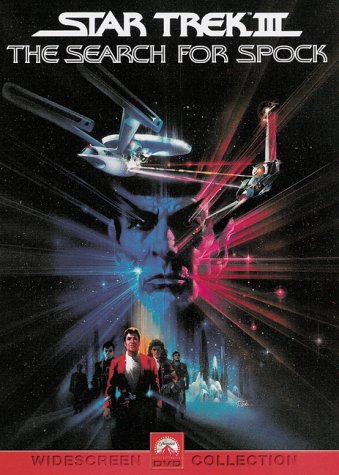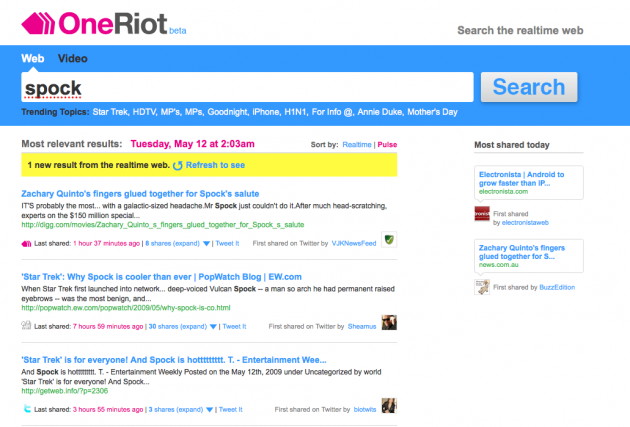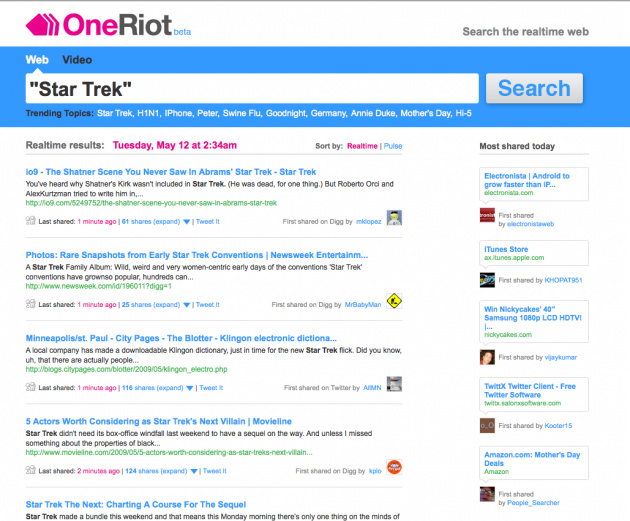 There was a lot of buzz last week upon the announcement that Twitter would soon expand its search offering to crawl links tweeted out on top of the tweets themselves. The ramifications of such a move are potentially large, as it would seem to be a way for Twitter to serve up a tailored, real-time view of what’s hot around the web. Who knows how long it will take Twitter to actually do that, but you don’t have to wait — another company, OneRiot, is launching the same functionality today.
There was a lot of buzz last week upon the announcement that Twitter would soon expand its search offering to crawl links tweeted out on top of the tweets themselves. The ramifications of such a move are potentially large, as it would seem to be a way for Twitter to serve up a tailored, real-time view of what’s hot around the web. Who knows how long it will take Twitter to actually do that, but you don’t have to wait — another company, OneRiot, is launching the same functionality today.
And scanning tweets is just a part of what OneRiot plans to offer. Today, it will also launch with a Digg link search, and soon it hopes to roll out live search results from a wide range of social services, Tobias Peggs, the general manager of OneRiot, tells me. But there are two keys to how this will work. The first is that OneRiot is crawling not just tweets and diggs, but is actually crawling the pages behind the links themselves. And second, this is all done in real-time. Content is indexed within 35 seconds, Peggs said.
Big claims are one thing, but how does it actually stack up? Pretty good from my initial tests (running on an incomplete dev server). For example, I did a search for “Spock” (not to be confused with the title of Star Trek III). In the real-time view, I got a glimpse of recent links related to Spock that people have been tweeting out and digging recently. These are done in reverse chronological order, and are constantly updating when someone tweets or diggs another link. (But the same links are bundled together to avoid clutter.)
If you’re more interested in quality over real-time views, you can simply switch to the “Pulse” mode, which shows popular recent links about your query. Both views show not only the link, but who the link was first shared by (on either Twitter or Digg), and can also be expanded to show all the retweets and other users who dugg the link. Those users’ names are all hyperlinks as well to their respective profiles on Twitter or Digg to give them proper credit for the finds.
Unlike FriendFeed, which recently implemented its real-time element, OneRiot takes the “queue” approach, where it indicates at the top of the results that there are new results waiting to be viewed. This is the same thing that Facebook and the actual Twitter Search use. Peggs says they built the system both ways to test it, and that users overwhelmingly favored this queue approach. The actual real-time view made some nauseous, he joked.
But why is OneRiot better than a service like Scoopler, a service we covered the other day that also does real-time search? Well, OneRiot believes the two are simply different. Scoopler is focusing on conversational search (basically what Twitter Search is now, searching for words in tweets), while OneRiot is about content search (more like Google). Eventually, Twitter wants to evolve into a cross between the two, and some reports indicate that Google is also interested in exploring this intersection. But for now, it would seem that OneRiot will have a bit of a head start in parsing the real-time shared web links.
One reason OneRiot believes that real-time content search is more valuable than real-time conversation search, is because conversational search is too easy to spam. We’ve already seen that in some regards when users manipulate the trending items on Twitter. That’s more difficult to do with links because OneRiot is looking at the content of the links and can pull out any that it thinks are spam. That would stop those links from appearing over and over again in the results.
Rather than focusing on making money right now, OneRiot is taking the Twitter approach, and trying to create a product that users will love first. But the future has potential to be pretty bright in terms of monetization when OneRiot decides to turn it on (assuming that it gets a lot of users). According to tests OneRiot has done, real-time searchers are more likely to search multiple queries. And they do so more often throughout a day than those doing a regular web search, according to Peggs. And because OneRiot is looking at the content within links, it can see if a link is to an article talking about Britney Spears wearing some kind of outfit, and will serve up a contextual ad that relates to that. But again, that’s down the road — the users have to come first.
To get those users, the service will first and foremost have to be good at what it does. It’s hard to know exactly how on a large scale OneRiot will stack up to Twitter Search or a simple Google Search for something, because as I mentioned, I’m testing it out on a limited development server right now. When it launches in a few hours, it should be more complete — but it is still very much a work in progress, according to Peggs. Still, the promise of real-time search is great. And it’s certainly more interesting that some of the stuff OneRiot was previously working on.
Being able to get a current look at what hot items people are sharing across social networks on the web is something people want. But can a startup like OneRiot live up to the real-time hype? We shall see.

